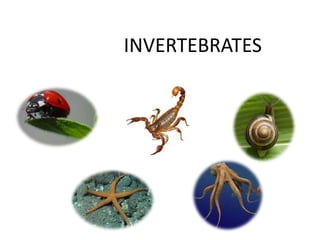Invertebrate animals
•Als PPT, PDF herunterladen•
4 gefällt mir•19,229 views
Melden
Teilen
Melden
Teilen

Weitere ähnliche Inhalte
Was ist angesagt?
Was ist angesagt? (20)
Andere mochten auch
Andere mochten auch (18)
1 grade unit_9_science_vocab_oviparous...herbivores...

1 grade unit_9_science_vocab_oviparous...herbivores...
Oviparous and viviparous animals (ScienceandEnglish.com)

Oviparous and viviparous animals (ScienceandEnglish.com)
Ähnlich wie Invertebrate animals
Ähnlich wie Invertebrate animals (20)
Classifying invertebrates and vertebrates in Science 6

Classifying invertebrates and vertebrates in Science 6
PROPERTIES AND CHARACTERISTICS OF THE ANIMAL KINGDOM

PROPERTIES AND CHARACTERISTICS OF THE ANIMAL KINGDOM
Mehr von Cienciastercerciclo
Mehr von Cienciastercerciclo (6)
Kürzlich hochgeladen
Kürzlich hochgeladen (20)
Powerful Google developer tools for immediate impact! (2023-24 C)

Powerful Google developer tools for immediate impact! (2023-24 C)
The 7 Things I Know About Cyber Security After 25 Years | April 2024

The 7 Things I Know About Cyber Security After 25 Years | April 2024
[2024]Digital Global Overview Report 2024 Meltwater.pdf![[2024]Digital Global Overview Report 2024 Meltwater.pdf](data:image/gif;base64,R0lGODlhAQABAIAAAAAAAP///yH5BAEAAAAALAAAAAABAAEAAAIBRAA7)
![[2024]Digital Global Overview Report 2024 Meltwater.pdf](data:image/gif;base64,R0lGODlhAQABAIAAAAAAAP///yH5BAEAAAAALAAAAAABAAEAAAIBRAA7)
[2024]Digital Global Overview Report 2024 Meltwater.pdf
From Event to Action: Accelerate Your Decision Making with Real-Time Automation

From Event to Action: Accelerate Your Decision Making with Real-Time Automation
Axa Assurance Maroc - Insurer Innovation Award 2024

Axa Assurance Maroc - Insurer Innovation Award 2024
Strategies for Unlocking Knowledge Management in Microsoft 365 in the Copilot...

Strategies for Unlocking Knowledge Management in Microsoft 365 in the Copilot...
IAC 2024 - IA Fast Track to Search Focused AI Solutions

IAC 2024 - IA Fast Track to Search Focused AI Solutions
Scaling API-first – The story of a global engineering organization

Scaling API-first – The story of a global engineering organization
Breaking the Kubernetes Kill Chain: Host Path Mount

Breaking the Kubernetes Kill Chain: Host Path Mount
Tata AIG General Insurance Company - Insurer Innovation Award 2024

Tata AIG General Insurance Company - Insurer Innovation Award 2024
2024: Domino Containers - The Next Step. News from the Domino Container commu...

2024: Domino Containers - The Next Step. News from the Domino Container commu...
TrustArc Webinar - Stay Ahead of US State Data Privacy Law Developments

TrustArc Webinar - Stay Ahead of US State Data Privacy Law Developments
Factors to Consider When Choosing Accounts Payable Services Providers.pptx

Factors to Consider When Choosing Accounts Payable Services Providers.pptx
08448380779 Call Girls In Friends Colony Women Seeking Men

08448380779 Call Girls In Friends Colony Women Seeking Men
Invertebrate animals
- 2. The main characteristics of animals • Animals are the most complex living things. • They usually have organs and systems. • They can perform the three vital functions. (Nutrition, interaction and reproduction) • They can move and interact with other living things. • Animal reproduction can be: – Asexual: Budding and fragmentation – Sexual. • They can be: – Viviparous animals: develop the embryo inside the mother’s body. – Oviparous animals: lay eggs outside the body. – Ovoviviparous animals: develop within eggs that remain inside the mother’s body.
- 3. Are they viviparous, oviparous or ovoviparous?
- 4. CLASSIFICATION OF ANIMALS Two groups: • Vertebrates: which have an internal skeleton with a backbone. • Invertebrates: which don’t have an internal skeleton.
- 5. SPONGES CNIDARIA WORMS MOLLUSCS ARTHROPODS ECHINODERMS INVERTEBRATES
- 6. VERTEBRATES
- 7. 1. PORIFERA • Sponges are aquatic animals. Most of them are marine. • They live attached to sand or rocks. • The body is perforated by pores and supported by small needles called spicules. • They have an internal cavity with an upper hole called osculum. • They are filtering animals. They feed filtering water and retaining food particles. • They can reproduce sexually or asexually (fragmentation o budding).
- 8. Water circulation in a sponge.
- 9. • Cnidaria are aquatic animals. Most of them are marine. • Examples: Corals, jellyfish, sea anemones, hydra. • Cnidaria have two body forms: – Swimming medusae: an umbrella shape floating freely. – Sessile polyps: a bag shape fixed to the ground. • They have a mouth with tentacles with stinging cells called cnidocytes and a gastrovascular cavity. • They can reproduce sexually or asexually (budding) • Cnidaria are carnivores and catch their prey. 2. CNIDARIA
- 10. • Worm includes animals with a soft, elongated body. • Three types: platyhelminthes, nematodes, annelids. • PLATYHELMINTHES: are flat worms. They live in wet environments or can be parasites. Ex: Planaria and Taenia. • NEMATODES: are cylindrical worms. They live in water, wet soil or parasites. Ex: Hookworms. • ANNELIDS: are worms with segments. The body is long and divided in rings. They live in wet soil or water. They have specialised systems. Ex: earthworms, leeches. 3. WORMS
- 11. • They are aquatic (squids, mussels, clams) and terrestrial animals (snails, slugs). • Organs highly developed. • Parts of the body: – The head: contains the sense organs. – The visceral mass: contains the internal organs. – The muscular foot: to move around, excavate or catch the prey. • They breath through lungs (terrestrial) or gills (aquatic). • They reproduce sexually. • Main groups: Gastropods (snail, slugs), Bivalves (mussels, oysters, clams), Cephalopods (squid, octopus, cuttlefish, nautilus) 4. MOLLUSCS
- 13. • They are terrestrial (spiders) or aquatic animals (crabs). • The body is divided into segments. (head, thorax, cephalotorax, abdomen) • They have hard appendages (antennas, legs, palps) • The body is covered by a rigid and articulated exoskeleton. • They breathe by gills (aquatic) or by tracheas (terrestrials). • They reproduce sexually and some of them have complete or incomplete metamorphosis. Classification: • Arachnids (spiders, scorpions, mites) • Crustaceans (Crabs, shrimps, lobsters) • Myriapods (Millipedes, centipedes) • Insects (grasshopper, butterfly, fly, wasp…) 5. ARTHROPODS
- 17. • They are marine animals. • They have hard skeleton, generally with spines. • They have an ambulacral system to move around. • They reproduce sexually or by fragmentation like starfish. • Examples: starfish, sea urchins, sea cucumber, brittle star. 6. ECHINODERMS